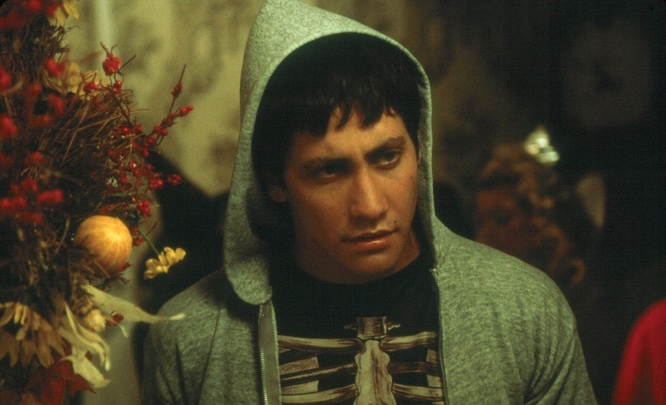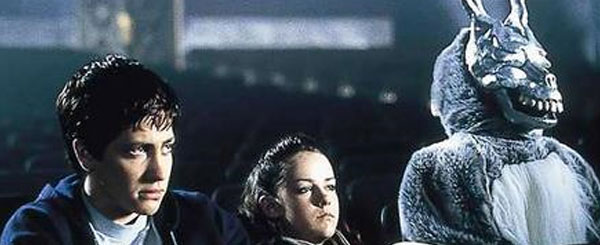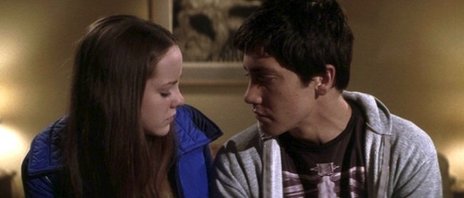Author's Note: This is not the first time Donnie Darko has been covered on Cinemablography. I actually made my debut on the site when my final paper – an analysis essay on suburbia and choice in the film - was published in the 2nd Science Fiction issue (Interested parties can view that piece here). I believe we are never done discussing a truly good film, especially not one as complex as this one is. Coming back to Donnie Darko after two years away has given me new insight. While my previous article touched on Donnie’s (Jake Gyllenhaal) mental illness, this article covers that topic more extensively – in fact, it is the focus. I hope that the two articles work in tandem to provide readers with a more thorough understanding of Donnie Darko. - M.H.
One hundred years ago, most people never spoke of mental illness. If they had it in their families, they often chose a Jane Eyre approach to the problem, isolating the affected relative from society. Institutions were not suitable for meeting sufferers’ needs, utilizing lobotomies and straitjackets instead of more helpful methods. As we have learned more about mental illnesses, it has become more socially acceptable to discuss them. This happens frequently through art.
Many compelling films about mental illness have been made. Like the majority of movies produced today, most have male protagonists. Sometimes this is intentional. Although “overall rates of psychiatric disorder are almost identical for men and women,” according to data from the World Health Organization, some disorders, such as antisocial personality disorder, are more commonly seen in men than women (WHO 1). Other times, it could be because a disorder is viewed as more typically “male” by the public – whether or not this is actually true. Schizophrenia – the illness featured in Donnie Darko (Kelly, 2001) – is one of these disorders.
Research from the World Health Organization states “there are no marked gender differences in the rates of severe mental disorders like schizophrenia and bipolar disorder that affect less than 2% of the population” (WHO 1). However, because of the societal expectations and stereotypes of and about mentally ill individuals – schizophrenic ones in particular - Kelly’s film is almost contingent on its protagonist’s gender.
Donnie Darko is not a film that is easy to interpret. While a “real” explanation does exist, many alternate fan theories persist. One of these theories states that the film has nothing at all to do with time travel (the actual explanation) and that none of its happenings were real, but just part of a schizophrenic episode that Donnie (Jake Gyllenhaal) had (Smith 1). People who believe this theory justify it by stating (correctly) that visual and auditory hallucinations are characteristic of schizophrenia (Smith 1). While this theory appears solid, it has a flaw: the fact that Dr. Thurman (Katherine Ross), Donnie’s psychiatrist admitted to giving him placebos (Smith 1). While the time-travel explanation is the most correct, I believe that the mental-illness view can coexist with the time-travel view, and that blending them makes an already beautifully complex film even richer.
Recent research has continued to confirm the correlation between schizophrenia and violence (Fleishmann, Werbeloff, Yoffe, Davidson, & Weiser 1). Unfortunately, this has led publics to believe that all schizophrenics are violent, and, therefore, that all schizophrenics are dangerous. To say this would be to make a false assertion; the person most in danger of victimization is the schizophrenic, since approximately 10 percent of people diagnosed with schizophrenia commit suicide (Health Research Funding). Compared with the stereotypes, Donnie’s violence stands out – property damage instead of assault or homicide. Even though he never actually gets caught for his crimes, people still believe that he committed them, based on his illness and past criminal history (he accidentally burned down an abandoned house and was sent to juvenile detention (Kelly 28)). When he does kill at the end of the movie, it has nothing to do with his illness. Instead, it is a crime of passion, triggered by the death of his girlfriend, Gretchen (Jena Malone). Gretchen’s death is the driving force for Donnie to go back in time. She saved him by loving him; now he must take the savior role for her.
A.D.A.M “Schizophrenia: Risk Factors” New York Times Heath Guide. 12 Oct. 2016. http://www.nytimes.com/health/guides/disease/schizophrenia/risk-factors.html Accessed 12 Oct 2016.
Anat Fleischman, Nomi Werbeloff, Rinat Yoffe, Michael Davidson, Mark Weiser. “Schizophrenia and Violent Crime: A Population-Based Study.” Psychological Medicine, vol. 44, issue 14, 2014. https://www.cambridge.org/core/journals/psychological-medicine/article/schizophrenia-and-violent-crime-a-population-based-study/FD65445E8C75A3BE9747F217456E551B
“21 Significant Paranoid Schizophrenia Statistics.” Health Research Funding, http://healthresearchfunding.org/21-significant-paranoid-schizophrenia-statistics/ Accessed 10 October 2016.
Kelly, Richard. The Donnie Darko Book. Faber and Faber, 2003.
Smith, Dan. “Alternative Explanations” Donnie Darko: The Tangent Universe. http://www.donniedarko.org.uk/alternative-explantions/. Accessed 10 October 2016.
“Gender and Women’s Mental Health” World Health Organization. http://www.who.int/mental_health/prevention/genderwomen/en/ Accessed 11 October 2016.





 RSS Feed
RSS Feed
